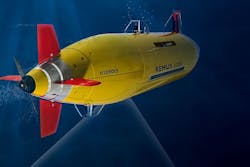Navy taps Metron for advanced development of machine intelligence for UUV surveillance
Officials of the Office of Naval Research (ONR) in Arlington, Va., announced a $29.8 million contract to Metron on Wednesday for an effort titled advanced autonomy for unmanned undersea vehicles.
This research project seeks to write and test software for advanced UUV autonomy that runs on government-provided hardware. The goal is to demonstrate emerging machine autonomy capabilities in several different kinds of military missions.
This is far from Metron's first technology development effort in unmanned autonomy. The company is involved in developing autonomy software for the ONR Large Displacement Unmanned Undersea Vehicle (LDUUV) project, which includes autonomy for the LDUUV involves autonomy software, computer hardware, and sensors.
In 2013 Metron won a $7.3 million ONR contract for in-lab integration and testing of autonomy and mission planning software with bench test hardware selected for deployment on the LDUUV.
That 2013 ONR contract to Metron contained two one-year options with the potential to increase the contract's total value to $18.3 million. As that original contract wraps up this year, Wednesday's new contract apparently is asking Metron to move forward with machine autonomy development for future Navy UUVs.
ONR's LDUUV project seeks to develop a large unmanned submarine able to operate in the open ocean and in coastal waters and harbors on missions lasting more than 70 days to gather intelligence, surveillance, and reconnaissance (ISR) information. The program is developing UUV autonomy and long-endurance propulsion systems for large UUVs.
Metron has developed autonomy software to enable the future LDUUV to avoid all vessels in its area of operations, including fishing boats. Company experts have been wrestling with autonomy challenges that include detecting and avoiding undersea stationary and moving obstacles, as well as path planning algorithms to minimize energy consumption while avoiding obstacles.
Other challenges involved with developing LDUUV autonomy software include detecting, locating, and identifying surface vessels; determining the intent of detected surface vessels; and detecting and avoiding all kinds of fishing nets and fishing gear, including mono-filament and twine nets which are difficult to detect. Once outside the specified areas, human operators may intervene over satellite links, if necessary.
In addition to Metron, other companies are working on autonomy and control for the future LDUUV. UUV designer Hydroid Inc. in Pocasset, Mass., also is developing an autonomy testing system for the LDUUV. Hydroid is a subsidiary of Kongsberg Maritime AS in Kongsberg, Norway.
Related: Navy demonstrates ability to launch surveillance UAVs stealthily from submerged submarines
Hydroid uses the Remote Environmental Measuring Units (REMUS) UUV as an autonomy testing system for LDUUV technology. The vehicle-control architecture is the same in the LDUUV and REMUS autonomous underwater vehicles, making it easy to move software from one vehicle to the other.
On the LDUUV program, several companies also are developing propulsion and power technologies for the future large unmanned submersible. Among the companies working on LDUUV power and propulsion technologies are Fuelcell Energy Inc. in Danbury, Conn.; Sierra Lobo Inc. in Fremont, Ohio; the Hamilton Sundstrand Corp. Sea Systems segment, in Windsor Locks, Conn.; General Atomics in San Diego; Lynntech Inc. in College Station, Texas; and NexTech Materials Ltd. in Lewis Center, Ohio.
The contract awarded to Metron this week has options that could increase its value to $33.9 million. Metron will do the work in Reston, Va.; San Diego; and Cambridge, Maine, and should be finished by March 2020.
For more information contact Metron online at www.metsci.com, or the Office of Naval Research at www.onr.navy.mil.
Learn more: search the Aerospace & Defense Buyer's Guide for companies, new products, press releases, and videos
